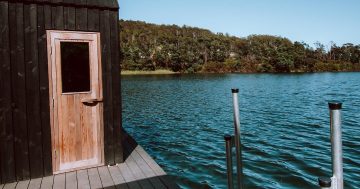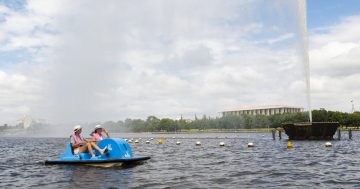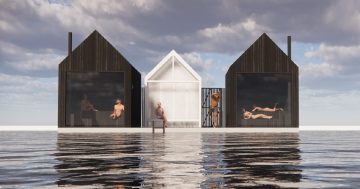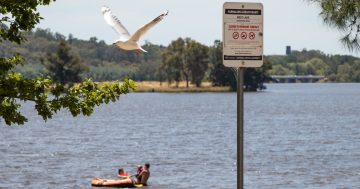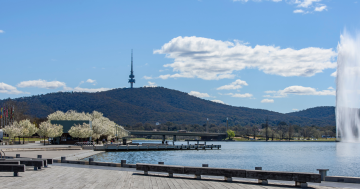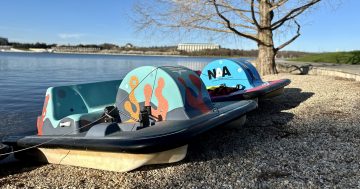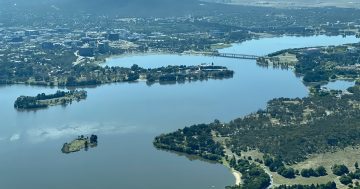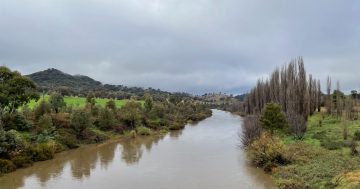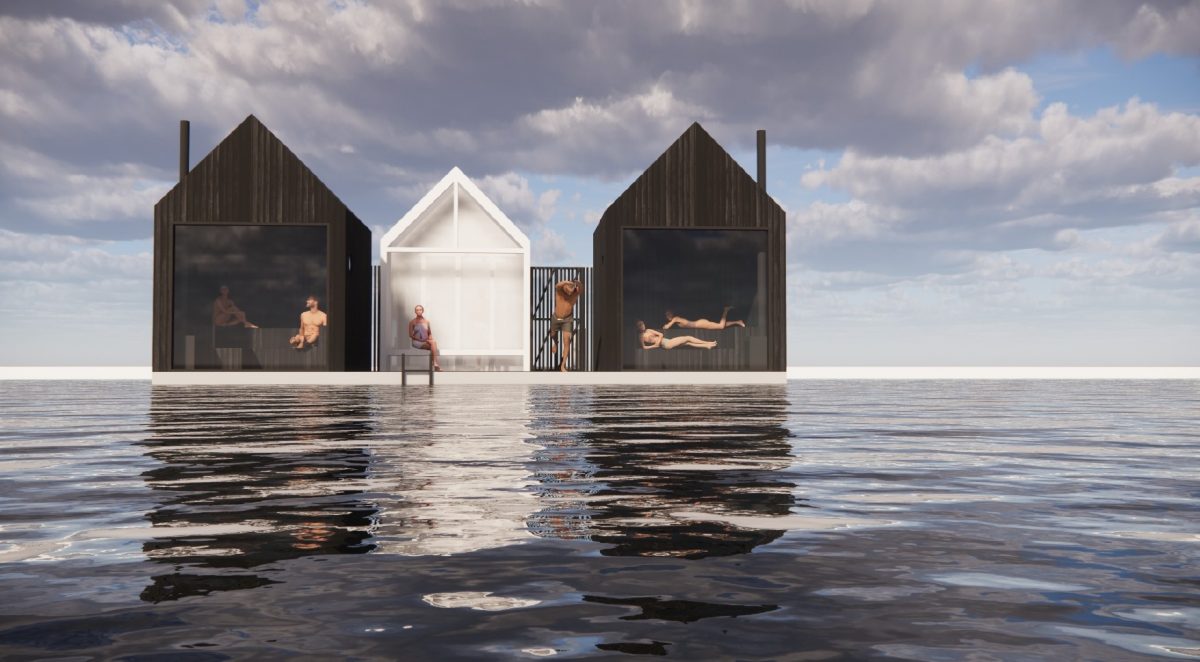
An artist’s impression of how Canberra’s floating sauna will appear. Photo: Nigel Reeves, Providence NDR.
Providence NDR, the same company behind a floating sauna on Lake Derby in Tasmania, is bringing one to Lake Burley Griffin later this year, in news that has Canberrans equally excited and, well, disgusted.
The plans, out for public consultation on the National Capital Authority (NCA) website until the end of the month, include two sauna rooms and a change room built on a 78.8 square-metre floating pontoon, connected to Yarralumla Beach by a 10.5-metre-long gangway.
The sauna will be heated by a woodfire in the traditional Finnish way to 90 degrees Celsius, so the thinking is users will be able to get those endorphins flowing by going between this extreme heat and the icy cold of the lake several times over a one-hour session.
But this is Lake Burley Griffin, a stormwater drain plagued by a history of blue-green algae and bacteria issues, not Lake Derby.
Or is it?
Providence NDR founder Nigel Reeves admits “there’s some local opinion about how the blue-green algae affects the quality of the water” but pointed out that “when you actually look at the data, it’s really not that bad”.
During the recreational swimming season between 2 October and 2 April every year, the NCA tests the waters for blue-green algae and bacteria levels every Monday at 10 locations.
These include Grevillea Park (East Basin), Central Basin (Captain Cook Memorial Jet), Lotus Bay, Acton Beach (Ferry Terminal), Acton Peninsula West, Yarralumla Beach, Yarralumla Bay, Weston Park East, Black Mountain Beach and Weston Park West.
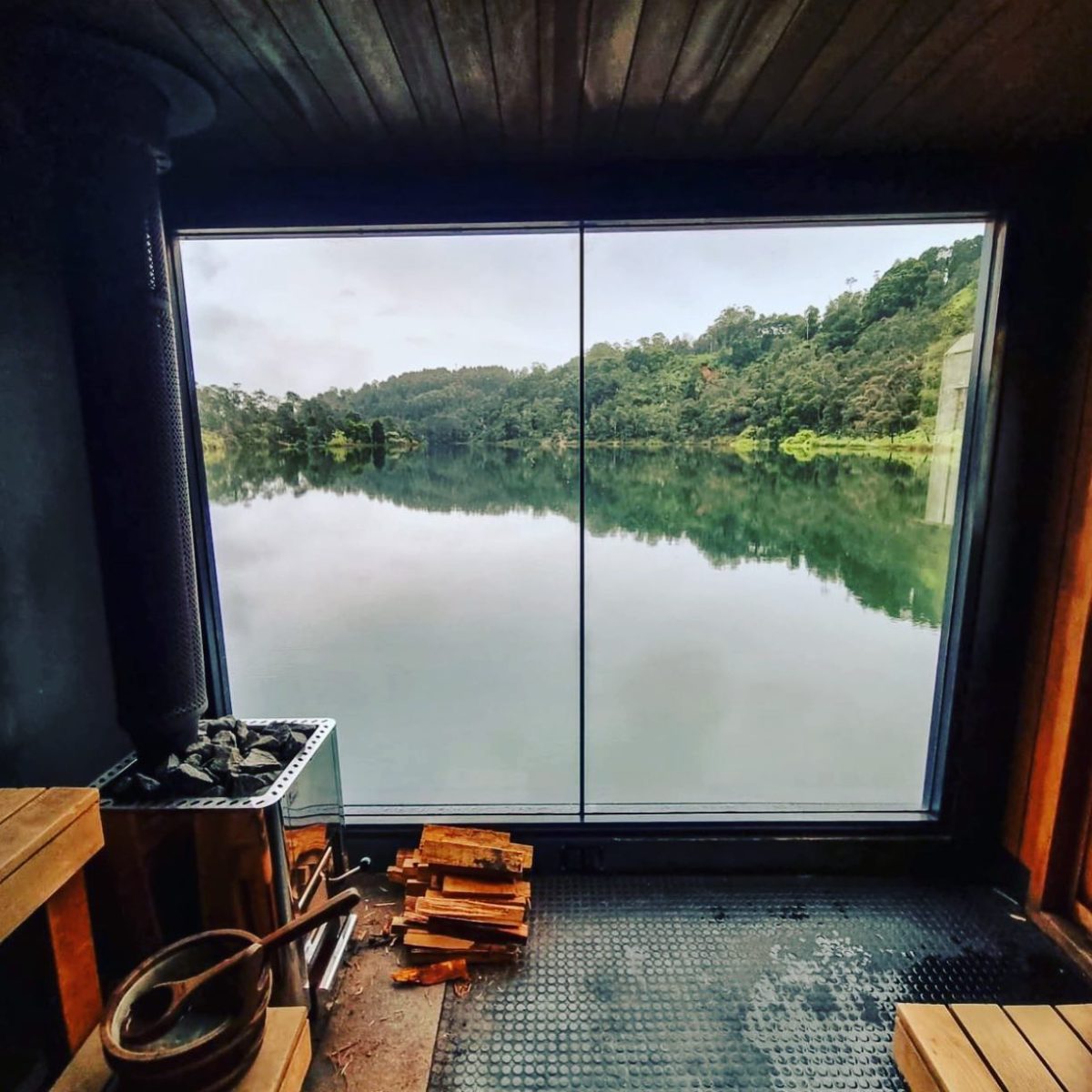
Inside the Lake Derby floating sauna. Photo: Floating Sauna Lake Derby, Facebook.
Depending on the results, published every Thursday afternoon on the NCA website, an alert, warning, or closure will be placed on the location.
These will rule out either “primary” or “secondary” recreation, or both.
Primary recreation “involves whole-body contact with the water, in which the entire body or the face and trunk are frequently immersed”, such as in swimming, bathing or windsurfing.
Secondary recreation includes “incidental contact with the water in which only the limbs are regularly wet”, such as in boating, sailing, canoeing, rowing and “other watercraft activities”.
Mr Reeves says this data “featured heavily” in the tender process, so even on those days when Yarralumla Beach is closed to swimming, the floating sauna is equipped with a separate water supply for cold showers.
“We’ve gone into our business model taking into consideration that, yes, from time to time, there will be elevated levels of algae,” he says.
“We’re just really pleased to be part of a growing number of people who are recognising the lake, for the vast majority of the year, is swimmable.”
Remind me again: What’s the problem with blue-green algae?
Blue-green algae is another name for cyanobacteria, which reproduce quickly and forms ‘blooms’ in still or slow-moving water with abundant sunlight and sufficient levels of nutrients, especially nitrogen and phosphorus.
Different species affect humans in different ways, from allergens that cause skin rashes to hepatotoxins known to damage the liver, neurotoxins that damage nerves, and – perhaps worst of all – cylindrospermopsin, which can damage the liver, kidney, gastrointestinal tract and blood vessels.
In 2020, a review commissioned by the NCA and led by the University of Canberra (UC) found two of the three species that bloom in Lake Burley Griffin during the warmer months emit both hepatotoxins and neurotoxins.
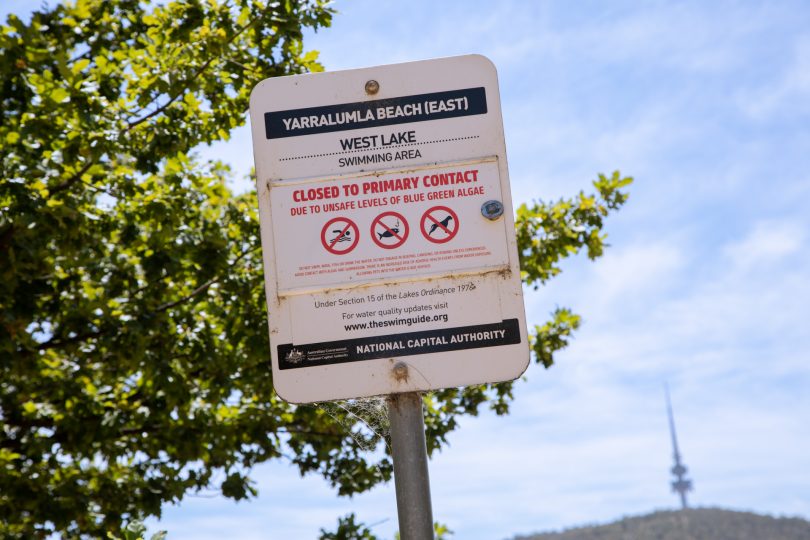
Providence NDR owner Nigel Reeves says there’s a contingency plan for when this happens. Photo: Michelle Kroll
Dr Rodney Ubrihien, a lecturer in Applied Chemistry within UC’s Faculty of Science and Technology, says these normally have to be ingested, but recent research also suggests there could be a link between exposure to airborne toxins and motor neuron disease (MND).
A 2015 study by Macquarie University found the Riverina has seven times the rate of the national average of MND cases, and frequent algal blooms in Griffith’s Lake Wyangan were identified as a possible cause.
“There’s circumstantial evidence … but as scientists, we’ve got an obligation not to spread information until there’s good evidence,” Dr Ubrihien says.
What’s the government doing about it?
The 2020 review looked largely at the quality of the lake’s surface water, but Dr Ubrihien says there were still questions over “the processes that happen deeper in the lake that are likely to drive the algal blooms”.
The ACT Government has commissioned UC to conduct another review, starting last year and running over at least two summers.
“We’re understanding some of the physical characteristics of the lake, what the flow is and where the waters separate to form different layers in the lake,” he says.
“It’s a key knowledge gap to understand the internal cycling of nutrients in the lake.”
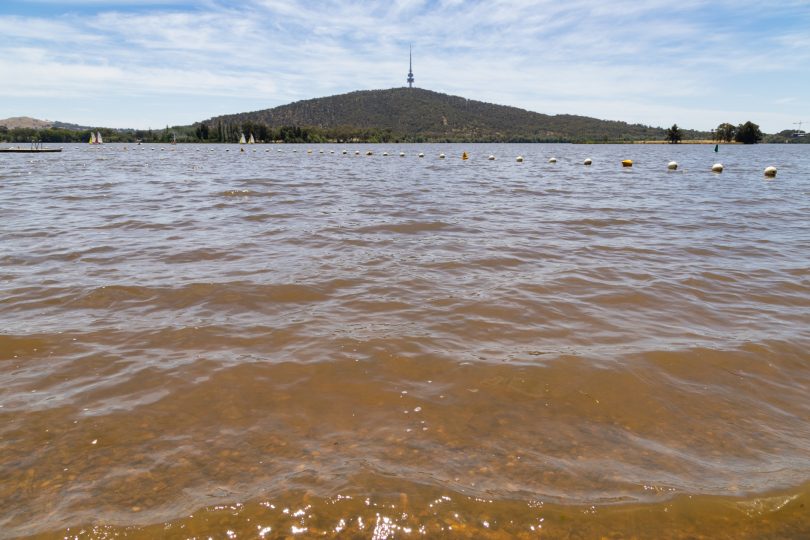
Yummy. Photo: Michelle Kroll
This study will underpin the development of a Healthy Waterways Plan for Lake Burley Griffin, according to the ACT Government’s Environment, Planning and Sustainable Development Directorate (EPSDD), which will be released for public comment in 2025.
“The plan will outline options available to improve water quality in the lake and enhance its value to the Canberra community,” a spokesperson told Region.
The spokesperson added the lake’s water quality has improved over the past decade “due to a combination of water-sensitive urban design and Healthy Waterways interventions including wetlands, swales and rain gardens that help to remove pollutants from stormwater”.
“The challenge for the ACT Government is to maintain or improve the water quality in the lake while accommodating development in the lake catchment.”
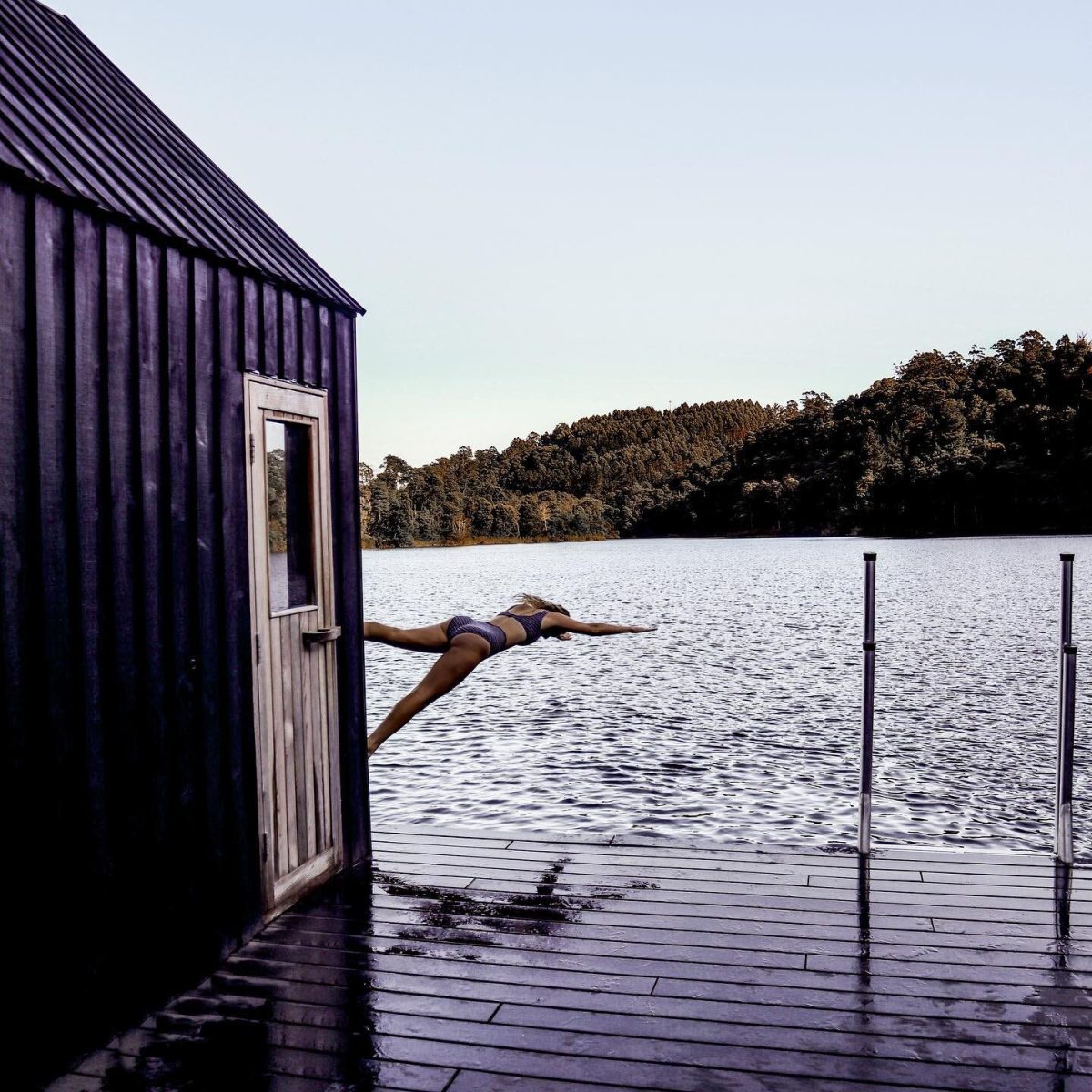
Will this be you? Photo: Floating Sauna Lake Derby.
So, can you swim in it?
The Sri Chinmoy Marathon Team holds two events a year in Lake Burley Griffin, including a 5 km swim in February and a 10 km in early December, as well as a triathlon in November, which includes a stint in the lake.
Race director Prachar Stegemann agrees the levels of bacteria and blue-green algae in the lake “was worse, for sure” 10 to 15 years ago, but they’re still “frequently” having to move events to other parts of the lake.
“That’s where testing many different locations around the lake is very advantageous because if one area where we plan to swim has a high bacteria reading, we can move to another area.”
Because the organisers refer to the NCA website before entering the water, he says the team has yet to have any swimmer come down sick.












